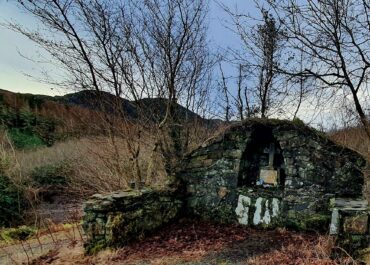Church, Clonca, Co. Donegal
In the townland of Clonca in County Donegal stands a fascinating ecclesiastical complex that tells centuries of Irish religious history through its stones.
Church, Clonca, Co. Donegal
The site centres on Clonca Old Church, a 17th-century building that cleverly incorporates fragments from much earlier structures. Built sometime after 1622 and used until 1827, this rectangular gabled church measures 14.15 by 6.15 metres internally and remarkably still stands to its original height. The building technique reveals its complex history; whilst the main structure consists of rubble and split stone with ashlar quoins, several of these corner stones feature punch-dressing, small chamfers, and roll-moulded edges, suggesting they were recycled from an earlier medieval church or perhaps from old memorial stones.
The church’s most intriguing features include a badly weathered carved stone lintel above the western doorway, whose figures remain tantalisingly unclear despite years of study. Inside, visitors can find a small portable bullaun stone tucked into the southwest corner, whilst two medieval grave slabs are fixed to the wall at the northeast end. The eastern gable, topped with a small stone cross, contains a large round-headed window, though sadly the cut stone mullions that once graced it, noted by Doherty in 1891, have long since vanished. A curious detail at the northwest corner shows a small stone bearing the carved symbols of a mallet and chisel above an inscription, possibly marking the work of a medieval mason.
The surrounding landscape adds layers to the site’s significance. In the field west of the graveyard stand two remarkable stone crosses; one restored and decorated, carved from a single slab, and another displaying a distinctive ringed head typical of Irish high crosses. A holy well sits in the northwest corner of the field across the southern road, whilst archaeological evidence suggests an ancient tochair, or raised roadway, once crossed the bogland to the south, likely connecting Clonca to the nearby Carrowmore site. Now protected as National Monument No. 25 and under the care of the Office of Public Works, this early ecclesiastical site continues to reveal glimpses of Ireland’s rich religious heritage through its weathered stones and scattered monuments.


